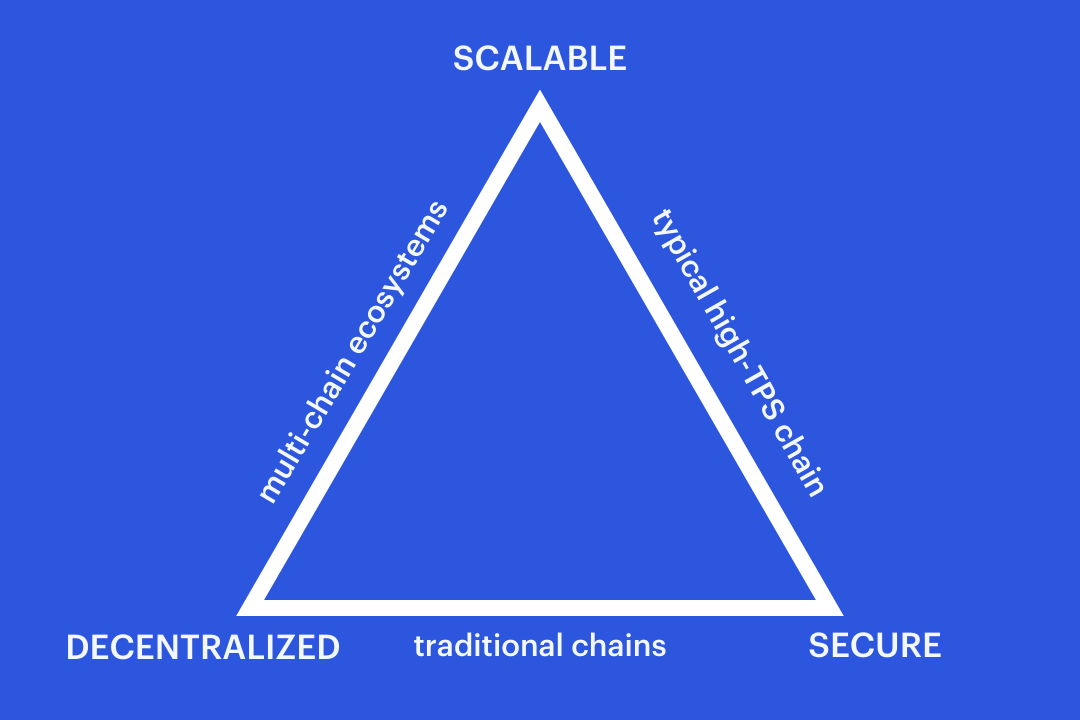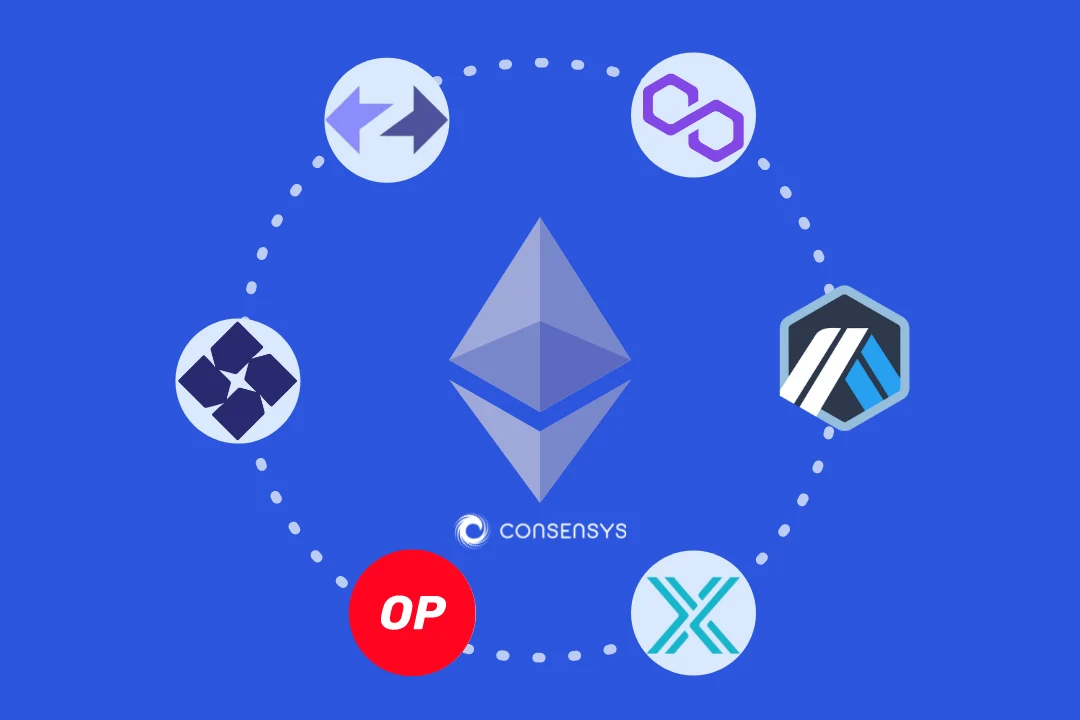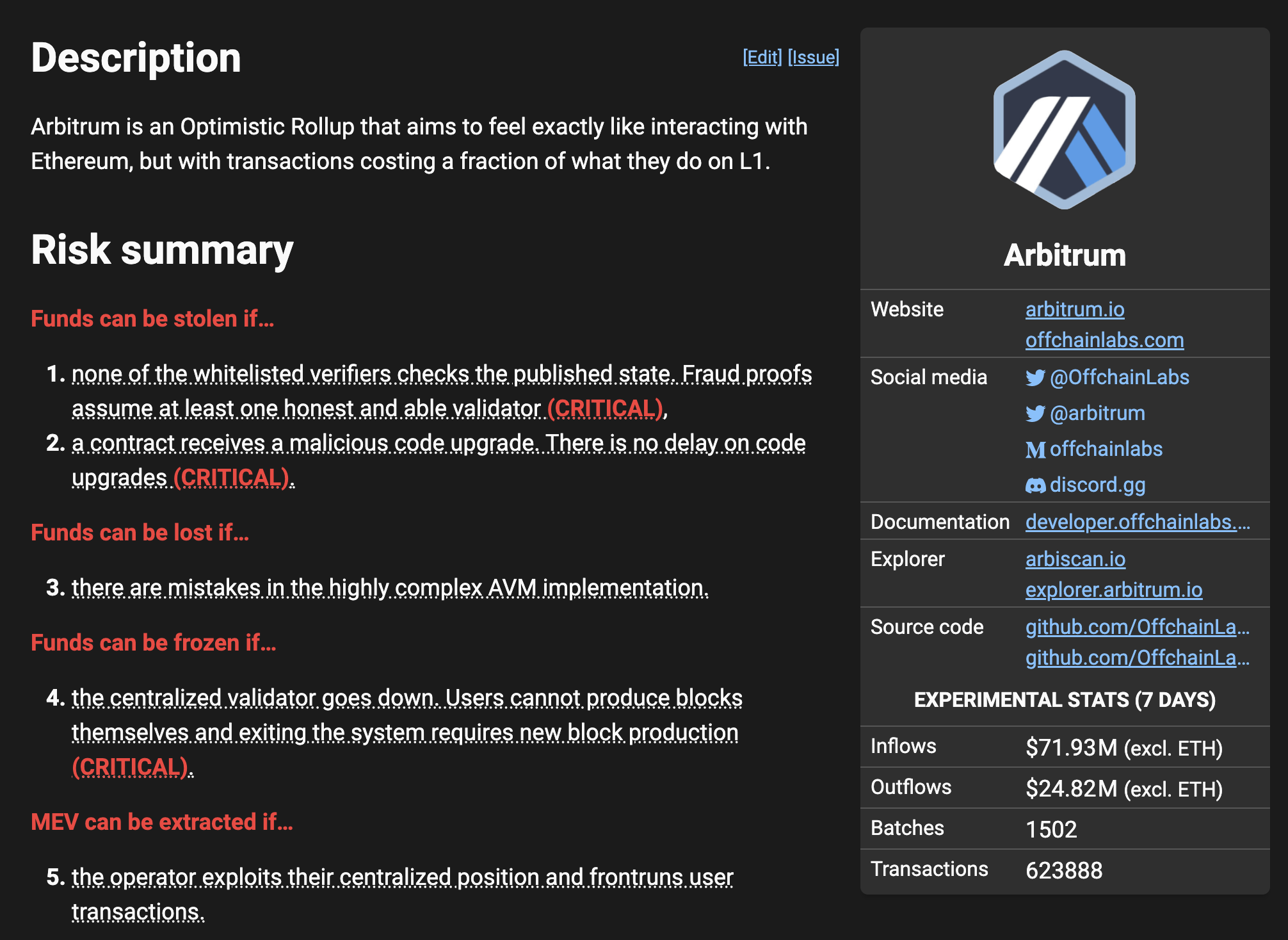As blockchains like Ethereum continue to expand, Layer 2, or L2 solutions present an opportunity to onboard millions of new users.
There are a myriad of options currently available. Most promising L2 solutions are so-called rollups like Arbitrum, Optimism, StarkNet, and zkSync to name a few. These vertical “mini blockchains” have very similar security properties that extend from Ethereum’s Mainnet. What they all have in common is:
Cheaper transaction fees (low gas)
Faster throughput
Trustless proving mechanisms
Rollups execute transactions in a new environment (i.e. off-chain) and bundle them together, before sending the updated state and transaction data back to Ethereum. They achieve security using proofs—some solutions use mathematical validity proofs applying techniques from zero-knowledge cryptography while others use game theory and staked value to allow for fraud proofs. Put another way, rollups are bridges to an off-chain state machine. The updated state that is executed on the rollup is then posted to Layer 1 and verified in a verification contract, either using validity or fraud proof schemes.
In this piece, we expand on four main questions we asked industry leaders who are building, researching, and growing layer 2s.
What are some major trends in scaling in 2022?
Will L2s flip sidechains/alternative L1s in total value locked (TVL) in 2022?
Which nut will be cracked in 2022? Which won’t?
As a new developer, should I choose to learn Optimistic or ZK rollups? Why?
Note that these responses are their personal opinions, and may not necessarily reflect that of their overall organization.
How do optimistic rollups work?
In the case of optimistic rollups, the operator commits the state transition to Layer 1, batching all transaction data together with the state transition. The correctness of the state transition is assumed until proven incorrect. With the given data anyone can check it. If someone can prove fraud by the operator, its deposit gets slashed, and the prover gets rewarded. After a predefined period, if no one is willing or able to commit a fraud-proof, the state transition is accepted on L1 and is considered final. This fraud window defines the withdrawal latency before anyone can withdraw assets from the rollup.
The two major players in this field include Arbitrum and Optimism which have seven-day withdrawal waiting periods.
How do validity rollups work?
In the case of validity rollups or ZK rollups, the operator commits a zero-knowledge proof for the state transition together with some transaction data to Layer 1. The zero-knowledge proof of the state transition—which is hard to create but comparably easy to verify—can be verified in the verification contract on layer 1. The proof shows that the state transition was correct. There are different zero-knowledge schemes in use—SNARKS and STARKS—which have slightly different properties and gas usages. There is almost no withdrawal latency with validity rollups as state transitions are proven to be correct mathematically, so the current state is always valid.
Two prominent teams utilizing validity proofs include Matter Labs (building zkSync) and StarkWare (powering dYdX, Immutable X, and more).
Diving into L222
While buzzwords are tantamount to a dynamic crypto environment, some of them have cause to stick. Although these Layer 2 scaling ecosystems are still quite young and have a lot of work ahead of them, 2022 is shaping to be an L222 year for Ethereum’s ecosystem as these various networks take off and gain traction. Ethereum’s high gas prices will continue to fuel L2 development. As teams continue to work on gas optimizations, user experiences, dev tools, and network constraints, they will start to bring a lot of developer attention which will bolster the Ethereum ecosystem as a whole.

The five biggest rollups currently secure $5.51B in tokens which can be used in those systems. Compared to the value locked in alternative L1s like Polygon PoS (>$5B) or Binance Smart Chain (>$13B), this is a relatively small amount. Also in terms of usage—measured by the number of daily transactions for example—the most used L2, dYdX, has around ~200k transactions at a tenth of Polygon PoS’ ~3 million transactions.
However, we believe achieving high values locked or usage by daily transactions is easier than achieving Ethereum-like security. So even if today, Layer 2s seem to be used only by a fraction of users, as technology advances, we will see more and more usage and value in L2s. Perhaps another way to put it: The difference between an L1 and an L2 is that in an L2 you are paying an extra fee for the privilege not to trust the off-chain system at all. The jury is out whether users will pay extra to remove this trust.
The best way to get a pulse on L222 is to connect with those deep in the throes of it. From research experts, founders of L2 teams, and blockchain engineers, we gather their perspectives on four key points.
Major trends in scaling in 2022
We identified four major topics in 2022 when it comes to scaling.
Undeniably, 2022 will be the year of bridges. That can mean two things as rollups are essentially a bridge that secures users' funds in a particular way. On the other hand, there are bridging protocols that allow for interoperability between different rollups. Patrick McCorry, Infura researcher, thinks, “It should eventually become seamless to transfer funds across rollups without interacting with Ethereum.” However, a trustless and decentralized bridging protocol for interoperability is still missing. “We’ll get really good at moving ERC20 assets between these chains, and we’ll start to see a movement of generalized messages and other application-specific bridges that are not simple ERC20s,” predicts Ben Jones, Chief Scientist at Optimism.
Furthermore, Ethereum’s merge to Proof of Stake will happen and with it “the narrative that Mainnet is for finality and Layer 2 is for computation will continue to build,” says Faina Shalts of Truffle Suite. The merge itself will not impact rollups a lot because it only changes the L1 consensus layer. But, danksharding, which might be focused on next, will have a tremendous impact, though most likely not in 2022. “Danksharding turns Ethereum into a unified settlement and data availability layer,” as Polynya states.
Another major trend we will see is fee reduction. So far, specialized validity rollups are in general cheaper than Optimistic rollups. (It is not clear yet how expensive generalized validity rollups are per transaction). Peter Robinson from Consensys Protocols asks, “Can optimistic rollups do things to reduce their costs?” There are ways to reduce costs there and the teams are working on optimizing compression techniques. In retrospect Angela Lu from Matter Labs mentions, “ironically, the timeline for optimistic rollups was too optimistic [last year], and the much simpler to build EVM-compatible sidechains with an order of magnitude lower fees stepped up to serve the demands of the market.“ As a trend, we might also see that low fees “is what users care about at the moment.” Maybe even way more than decentralization. “But I’d say there’s also a message to land with Ethereum instead of alternative L1s being an antithesis,” as Ankit Maity from Polygon shares.
The last trend that the experts identified was about developers. As a trend, Faina Shalts sees developers writing L2-native protocols, instead of just porting across from existing L1 Solidity code. Specialized L2 smart contract developers might emerge coding in Cairo or Zink. And more specifically, Angela Lu thinks vertical innovation [innovation within a rollup technology], with the rise of L2-native applications and blockchain use cases that could not be built under the constraints of Mainnet Ethereum, will emerge.
Will L2s flip sidechains/alternative L1s in TVL in 2022?
Flipping all sidechains and alternative L1s seems unlikely in 2022.
“The security and decentralization of Ethereum is appealing to developers and those who have been in the space for a long time, but at least some L1s will continue to enjoy prominence,” according to Faina Shalts.
“This is the year of optimistic rollup adoption,” says Ankit Maity, though he doesn’t believe they are ready for the next billion users.
Ben Jones suggests a combination of factors will have an upward influence on L2s in terms of TVL and transaction volume:
Gas costs becoming further optimized and less expensive
People realizing security matters
Regular users gaining trust in these L2 systems which are inherently harder to build because of their various proving mechanisms
While we will likely see increased TVL on L2s in 2022, we’d need to also see easy-to-use, accessible, and cheap cross-chain bridges for capital to move over from alternative L1s.
Angela Lu remarks, “In the long term, TVL will trend towards chains that offer more security and decentralization at reasonable costs and where applications are innovating. While we fully trust our design, a 2022 timeline for complete L2 takeover is rather aggressive, as we would encourage users not to move large amounts into any L2 until they’ve been sufficiently battle-tested on Mainnet.”
To her point, it’s important to remember that these Layer 2s are early tech, so they are not automatically safe to use. L2Beat has risk summaries detailed for each rollup which you can take a look at:
All in all, the complete homogeneity of blockchains does not seem realistic. A lot of alternative L1s like Solana and Binance Smart Chain are cheaper, though less secure—capturing significant market cap. Some transactions don’t need to be as secure as others, and some people may not even care about decentralization, just cheaper fees and faster transactions.
A big malicious attack on these networks could alert people to the security risks and prompt a migration. Remember last week’s incident on Solana with the Wormhole bridge?
Though maybe we should heed Patrick McCorry’s stance on not being concerned about L2s flipping sidechains, but rather look to see if L2s can flip the TVL held by a centralized exchange like Coinbase.
Which nut will be cracked in 2022? Which won’t?
Almost all experts are talking about EVM equivalence when it comes to tough nuts yet to be cracked in 2022.
For Optimistic rollups, we will see them gaining traction in usage and tooling due to their almost EVM equality. “What we’re seeing is tons and tons of people deploying their projects as they realize it's literally as simple as changing the chainID and running the exact same script you did on Mainnet,” Ben Jones observes. But also as different EVM compatible scaling solutions go into production, the nuances of compatibility and costs associated with it will become clearer to users and developers.
For validity rollups, however, expectations fall into a continuum. Some experts predict conservatively that we will see good workarounds for transpiling code to the EVM. Some see zkEVM Proof of Concepts feasible in 2022. And some even think we will see efficient zkEVM provers on Mainnet.
What we will not see in 2022 is trustless and seamless interoperability between L2s—which is essentially bridging. There are some protocols out there and some teams building on them. Most bridging projects as of today are indeed trusted and centralized.
As a new developer, should I choose to learn optimistic rollups or zkRollups? Why?
If you’re a new developer, don’t fret so much. The consensus here leans towards learning Solidity and EVM.
“Solidity is the smart contract language with the most extensive developer tutorials, the most mature developer tooling, and the largest developer community to support one’s journey into smart contract development,” says Angela Lu.
As a new developer, you may want to be able to do things quickly and build intuition. The developer experience in Ethereum has dramatically improved over the past three years, and by learning Ethereum, you’ll have the foundation necessary to build on an EVM-compatible optimistic rollup, which doesn’t hold for validity rollups.
“Validity rollups currently require knowing a different language that is optimized for the computation needed to make them work. For instance, to really get the benefits Starknet promises, you’ll want to know Cairo. This year is the absolute best time to learn it, as the language is pretty new and a junior developer could develop expertise quickly. There’s no question we’ll see ‘Cairo Smart Contract Developer’ roles soon, and ‘Zinc Smart Contract Developer’ roles. Specializing in one of these is a risk because both major validity rollups are promising eventual EVM compatibility, but I think it's a pretty good return/risk calculation to learn one of these! Caveat -- there aren't nearly as many resources for learning Cairo or Zinc as there are for learning Solidity, so they will be harder to learn for some time,” according to Faina Shalts.
As a new developer, you may want to avoid jumping into an esoteric programming language right now which could be prone to extreme change and possible bugs, as that would be a more challenging route. However, the team at StarkWare encourages developers to familiarize themselves with the idea that, “each marginal transaction lowers the per-unit transaction cost removing the gas constraints that exist on L1, and opens up a world of new capabilities.”
Depending on your experience level, you may want to explore validity rollups to deploy an L2-native application. This could offer a larger design space according to Angela Lu from Matter Labs because:
Fast L1 <> L2 asynchronous message passing makes hybrid applications that tap into the applications and liquidity of L1 feasible
The Volition design enables different classes of users and applications across the entire security/cost spectrum to compose and interoperate in one system that spans across many data availability solutions
The ability to post only the difference in state to
calldatawill offer significant cost savings over an Optimistic rollup.
Nicolas Liochon Head of R&D at Consensys emphasizes that as a new project and developer, “a reasonable plan anyway is to evaluate the properties of both validity and optimistic rollups, and see if optimistic rollups are good enough, at least short term, and then wait for the dust to settle on the zk-evm debate.”
Developer resources available to you right now:
Ultimate Hackathon Survival Guide - Learning Web3 (basics, intermediate, and advanced level resources)
Cryptocurrency class 2022 taught by Patrick McCorry
Consensys Academy Blockchain Developer Bootcamp
Smart Contract Engineer to learn Solidity and Vyper
The Infura Platform for your comprehensive developer toolkit
Blockchain Trilemma, Be Gone
The blockchain trilemma refers to a widely held belief that decentralized networks can only provide two of three benefits at any given time with respect to decentralization, security, and scalability.

Rollups are modular executions aiming to solve the trilemma. They are free from the responsibility of consensus and data availability by creating a transaction execution environment separate from Ethereum. This allows rollups to benefit from high scalability, security, and decentralization, without compromising on either.
Final Thoughts
In summary, the major trends we’ll see in scaling in 2022 include bridges, fee reduction, the Merge, and developer migration. We don’t see Layer 2’s flipping alternative Layer 1’s in TVL anytime soon though EVM compatibility and EVM equivalence will progress dramatically this year. Trustless and seamless bridging will take more time to mature as it is a challenging nut to crack. If you are a developer looking to branch out into the space, start by learning Solidity!
Ideally in the future, new users won’t even need to know they’re on an L2. It will be a seamless experience with them never having to go back to Mainnet, while still inheriting its security. The proliferation of bridges, mature L2 infrastructure, and fiat on-ramps will aid in developer attention and user traction.
Hopefully soon, most people will use this technology without the need to know what Layer 2 or EVM means. Until then, we try to stay on top of the ecosystem and the development that is built and researched by many skilled and interesting people.
Thanks to everyone who spent time discussing L222 with us, provided their thoughts and feedback, and continue to work on L2 infrastructure:
Maurelian, Optimism
Ben Jones, Optimism
Ankit Maity, Polygon
Angela Lu, Matter Labs
Tyler Perkins, Matter Labs
Liron Hayman, Starkware
Fred Lacs, Arbitrum (Offchain Labs)
Faina Shalts, Consensys
Patrick McCorry, Consensys
Nicolas Liochon, Consensys
Peter Robinson, Consensys
David Killen, Consensys

